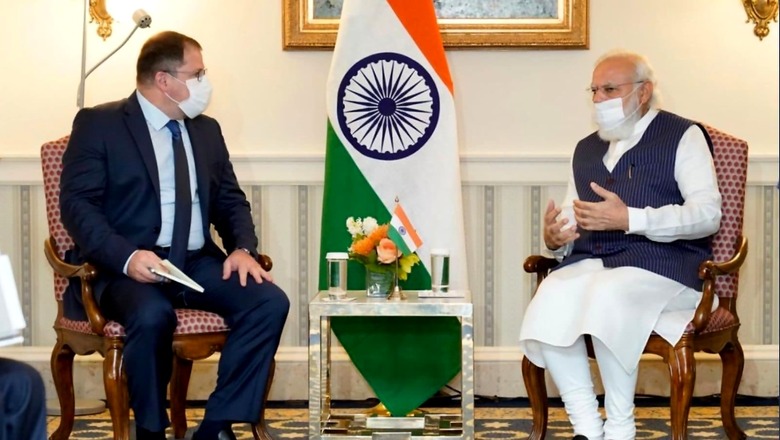
views
Traditionally, the semiconductor supply chain has operated in the background, enabling everything from everyday appliances and devices to cutting-edge defence equipment. This complex and hyperglobal supply chain worked so seamlessly that its functioning got taken for granted.
This perception has changed in a matter of months. First, semiconductors became a domain of confrontation between the US and China. And then, the demand shock of COVID-19 led to a severe shortage of chips in automobiles, medical devices, and other sectors. And finally, fears of a Chinese takeover of Taiwan—which alone accounts for nearly 73 per cent of the world’s global contract chip manufacturing—have made countries scramble for alternatives. And so, from being at the margins of the technology policy agenda of several countries, semiconductors have become a primary focus area. Little wonder then that the first in-person Quad Summit meeting on September 24 had semiconductors on its agenda.
ALSO READ | With Boost to Manufacturing and FDI, India is the Winner at Quad
What Got Discussed at Quad Summit?
One of the outcomes of the first-ever Quad summit-level meeting on March 12, 2021 was establishing a critical and emerging technologies (C&ET) working group. At the time, there was no common understanding of which technologies classify as “critical” and “emerging”. The technology cooperation plan appeared to be too dispersed to enable any concrete action.
Six months later, we have a much clearer picture. The Quad leaders’ summit identified four focus areas: 5G communications, technical standards collaboration, biotechnology, and semiconductors.
On semiconductors, Quad launched an initiative to “map capacity, identify vulnerabilities, and bolster supply-chain security for semiconductors and their vital components.” The summit fact sheet adds that the Quad partners should collectively support a diverse and competitive market for producing semiconductors. The last sentence is significant—it signals a shift in mindset from national indigenisation to strategic cooperation. Here’s how.
Starting 2015, China’s ‘Made in China 2025’—a state-led industrial policy for technology, including semiconductor indigenisation—unsettled many democracies. In response, these countries started offering massive incentives and subsidies to attract local semiconductor manufacturing.
In February 2021, US President Biden signed an executive order to address the shortage. Earlier in April 2020, India launched its production-linked incentives (PLI) scheme to ‘crowd in’ investment in this sector. Then in June 2021, Japan formulated a draft growth strategy promising generous financial incentives to cutting-edge chip-making facilities. Despite these initiatives, semiconductor self-sufficiency remains a distant dream for all these countries.
The complexity and costs of the semiconductor supply chain demand a global supply chain. Rapid improvements in the processing capabilities of our devices have happened precisely because of a globally diversified semiconductor supply chain. This approach has allowed companies to specialise and excel in one or two stages of the supply chain, relying on companies from other countries for the remaining stages. Semiconductor Industry Association, a prominent industry voice, estimates that a typical semiconductor production process spans 4+ countries, 3+ trips around the world, 25,000 miles travelled and 12 days in transit. To overturn the economic logic of comparative advantage, countries would need to continually divert their scarce resources to build and support indigenous semiconductor manufacturing.
This is why a multilateral approach such as the Quad’s Semiconductor Supply Chain Initiative makes sense. Instead of aiming for national self-sufficiency, Quad countries seem to agree now that they need to ensure redundancy in the global semiconductor ecosystem so that an adversary does not dominate it.
Multilateral strategic cooperation can achieve this goal. Using countries’ existing comparative advantages instead of duplicating them will lead to sharing costs and complementing each other’s strengths to accelerate innovation.
It is in this respect that Quad is suitable for semiconductor collaboration. The US is a global leader in the semiconductor design stage. American companies also dominate two key stages upstream to the design process—electronic design automation (EDA) and licensed intellectual property. Japanese companies enjoy a dominant position in semiconductor materials and chemicals used for manufacturing chips. Japan also leads the market in silicon wafers, substrates on which ICs (integrated circuits) get made. Australia occupies an important place in the broader electronics supply chain as it has access to critical materials and advanced mining capabilities. Finally, semiconductor design requires large numbers of skilled engineers, where India’s strength lies. Collectively, the Quad has most of the building blocks to make the semiconductor supply chain resilient and China-free.
ALSO READ | Prime Minister Narendra Modi’s Big Message to US Industry—India is Open for Business
Is This Supply Chain Initiative Enough?
Mapping the supply chain vulnerability should only be a first step of the collaboration. The grouping can directly bolster supply chain security in the following ways.
One, Quad can form a consortium aimed at building a diversified semiconductor manufacturing base. The consortium could create a roadmap for new manufacturing facilities across Quad countries. The focus should be to collectively have access to manufacturing at the leading-edge nodes (5 nanometres and below) and critical trailing-edge nodes (45 nanometres and above). The latter will continue to remain workhorses for automotive, communications (5G), and AI.
Two, Quad can sponsor new standard developments such as composite semiconductors and create one centre for excellence (CoE) in each Quad country in an area of its immediate interest. For example, Australia could host the CoE for new materials in electronics, Japan could host the CoE for silicon manufacturing equipment, and the US and India could host CoEs on specific fabless design architectures.
Three, Quad can facilitate strategic alliances between companies in each other’s countries. For example, faster visa processing and lower employment barriers for semiconductor professionals in Quad member countries could facilitate higher technology exchange and joint development levels. Removing technology transfer restrictions could make overseas licensing easier. Easing capital flows in this sector could again foster more joint development projects.
What Does India Gain?
India should use the Quad collaboration to get a Japanese or American company to manufacture semiconductors in India, even if it’s at a trailing-edge node such as 65 nm. Collaborating with partners would minimise the risk of failures while ensuring India’s core defence and strategic interests are secured.
Moreover, the AUKUS defence alliance has shown that the US is willing to share sensitive technologies with key partners, something it wasn’t amenable to in the past. This new technology alliance mindset should become the norm in Quad as well. India should push for the US to lower investment barriers and reduce export controls.
Apart from IC manufacturing, India should double down on its core strength. In a Takshashila Institution report titled India’s Semiconductor Ecosystem: A SWOT Analysis, we observed that India has an outright advantage in semiconductor design. The next step should be to encourage indigenous intellectual property creation. PM Modi’s meeting with the Qualcomm CEO is vital in this regard. With more multinational companies moving their cutting-edge semiconductor design to Indian offices, the Indian ecosystem will develop organically.
Finally, given India’s developmental challenges, its financial incentives for technology R&D are unlikely to match what richer countries can afford. In such a situation, India must adopt an allied approach to technology cooperation. For developing critical and emerging technologies, multilateral cooperation is a necessity, not a choice.
Pranay Kotasthane is deputy director, Takshashila Institution. He has co-edited India’s Marathon: Reshaping the Post-Pandemic World Order. The views expressed in this article are those of the author and do not represent the stand of this publication.
Read all the Latest News , Breaking News and Ukraine-Russia War Live Updates here.


















Comments
0 comment